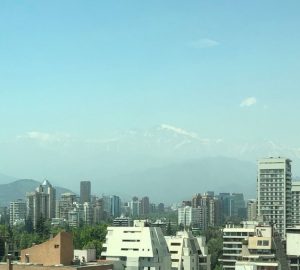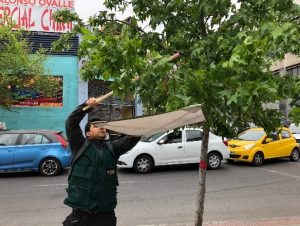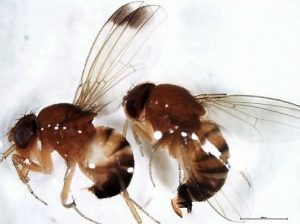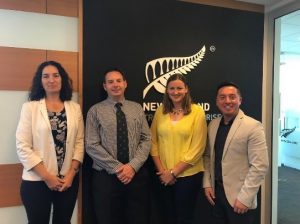Simon Cook’s Nuffield Thoughts: Part 8
Chile
Very early on I made the decision that I wanted to include Chile in the list of countries that I visited as part of my travels. Obviously as the other major southern hemisphere producer of kiwifruit they are our strongest direct competitor, so I was keen to use the opportunity to learn a little about the production of kiwifruit in Chile. The other major reason I was interested in visiting Chile was the recent detection of Brown Marmorated Stink Bug (BMSB) in central Santiago. 
Initial BMSB incursions into new countries are often initiated in urban areas – which coincides with the greatest movements of people and goods. The expectation is that if we at some stage do find an established BMSB population in New Zealand it will most likely be in an urban environment. What is happening in Santiago therefore provides us with a fantastic opportunity to learn how to try to control this pest with the difficulties an urban environment poses.
Earlier this year KVH helped bring Ilania Astorga to New Zealand to talk about the response to BMSB in Santiago. Ilania works for SAG in Chile, basically the equivalent of MPI here in New Zealand and is responsible for managing the response team, surveillance and trapping activities. I was able to spend a day with Ilania talking about the history of BMSB in Chile and how they were dealing with this pest.
BMSB has been picked up at Chilean ports with increasing frequency since 2010 with the majority of finds coming in the far north in shipments from US. In 2011 it was declared a quarantine pest in Chile and fumigation protocols were put in place. This reduced but did not entirely eliminate BMSB border finds. The first BMSB found inside the country away from the border was in 2011 in central Santiago. A thorough search of the surrounding area could not identify any more, so it was assumed to be a single interception.
In March 2015 a live insect was again found in central Santiago close to the location of the original 2011 find. Following a search of the area a second live insect was found. A local company notified SAG they had found live BMSB in furnaces being imported from China. Once again, this notification was in close proximity. In all there were 6 different identifications within Santiago in 2015.
The following year SAG staff confirmed the presence of multiple life stages of BMSB indicating a breeding population. In March 2017 BMSB was declared under official control and a surveillance and trapping program was initiated with support from experts in New Zealand and the US. The trapping program involved placing sticky cards in trees that were laced with pheromones to attract BMSB. As well as inspecting the sticky cards they also used a stick to beat the surrounding foliage with a net underneath to catch any BMSB that were dislodged. The vast majority of BMSB captured have been through the beating of surrounding foliage in dicating that the pheromone cards will attract BMSB into the vicinity but not onto the cards themselves.
dicating that the pheromone cards will attract BMSB into the vicinity but not onto the cards themselves.
I talked to Ilania about the support and feedback they were getting from the horticultural industry about the incursion. Given the limited budget SAG are operating under they can only afford to carryout the trapping and inspection in Santiago at this stage. They hoped that they would be able to encourage industry to engage in trapping and monitoring in rural areas. So far SAG has been totally disappointed by the lack of support from the horticultural industries that BMSB poses a threat to. I was staggered to learn that despite presentations to growers about the obvious risk and impact that they were totally unwilling to engage with and support SAG. Ilania said the exact same pattern had emerged before PSA that the kiwifruit industry had no interest in supporting SAG until PSA was discovered in orchards. I fear it will be the same with BMSB, until orchards are being directly impacted and incurring losses – there will be a total lack of interest.
This caused me to reflect on the progress our industry has made since the PSA incursion. The fact that we now have an industry body KVH, that with the support of growers actively engages with MPI, prepares response plans and engages in incursion simulations places us far ahead of any industry I have seen worldwide. I have also in the past heard several growers ask whether they can buy or be supplied with fruitfly traps to install and monitor on their own orchard, to try to improve our chances of early detection. This active engagement by industry drastically increases our chances of dealing with any potential future incursions.
At this point in time the pheromone trap and physical capture are the only control methods being employed. They had only just started the trapping program when I visited but they were finding small numbers 3 weeks earlier than the previous year. It will be interesting to see if there is significant growth in the population this year or if the current trapping method is able to contain the population.
SAG have been closely watching the progress of the application to import the samurai wasp into New Zealand and given the positive outcome, will look to use our research as the basis to lodge an application of their own. Despite Chile being a competitor, it is absolutely in our best interests to assist with their application in any way because the potential to learn lessons on how to effectively release Samurai wasp would prove invaluable if or when it is required here.
The other avenue for control being investigated is the potential use of drones to apply sprays to trees in the vicinity of the outbreak. A forestry company in Chile is currently working on using drones to spray trees and Ilania was hopeful they could use that knowledge to run a controlled spray application program in Santiago.
Scion in New Zealand are actively researching the potential for drones to be used here as an urban control method. The days of aerially spraying over Auckland like we did for painted apple moth in 2002 are well and truly past with the public relations nightmare that created effectively ending this as an option. However small direct applications by a drone to individual trees minimising any drift does potentially give us a publicly acceptable option that could well be used against BMSB, fruitfly or a range of other pests and diseases.
Ilania also introduced me to Fabiola Olivares who gave me a presentation on Drosophila suzukii better known as spotted wing drosophila or SWD. SWD is a fruit fly like insect that is native to southeast Asia that has been causing significant problems for growers in Europe and America. In 2010 it started to spread widely across the US and in 2014 it began to spread through South America. It had spread to Brazil, Argentina and Uruguay and in 2017 was first found in Chile. SWD also features in KVH’s most unwanted list.
Since 2014, SAG in Chile had been actively looking for and now have up to 2,000 traps spread around for SWD. The first find was in May 2017 near a road that led to a border pass into Argentina. In the first part of June there two further finds in nearby regions. Small numbers of SWD continued to be found through until April and May of 2018 when the number of finds particularly in Los Rios region exploded into the thousands. The increase in numbers led to the declaration of a phytosanitary emergency.
Wild blackberry is endemic around Chile and is a perfect host for SWD making containment or eradication almost impossible. SAG at this stage are just monitoring the spread of SWD and are preferring to focus on education for growers on how to control SWD on their orchards and minimise the impacts that it will have.
While I was in Chile, I also had the opportunity to meet the New Zealand ambassador to Chile, Bolivia, Ecuador and Peru. Jacqui also had Rhianon Berry and Erwin Tapia from NZTE and Maria Jesus Prieto from MFAT with her. Given the trade difficulties raised between Chile and New Zealand they were interested to understand the Nuffield program and how that related to Chile. They are keen to see ongoing co-operation in agriculture between the two countries and see this as a way of relieving the tension politically between the two countries. It was also a good opportunity for me to question them about Chile in general and what they saw as some of the opportunities and challenges facing local growers. 
I spent the weekend going for a drive and exploring a little of Chile. Chile is a beautiful country that is an exceptionally long thin slice with coast on one side and the ever-present Andes mountain range on the other. The country ranges from the Atacama Desert in the north to almost the Antarctic in the south. A small coastal mountain range in concert with the Andes creates a beautiful valley that stretches to the north and south of Santiago. The valley is home to a diverse range of horticultural crops such as avocados, grapes, pip and stone fruit and of course kiwifruit just to name a few. I have to say when you are standing looking at a kiwifruit orchard with snow covered mountains in the background it is truly beautiful, but I can’t help being amazed that they don’t get wiped out be frosts every year. The valley is also exceptionally dry and brown which was reminiscent of California with constant irrigation necessary. Water supply is not an issue with snow melt from the Andes providing an abundant but seasonal supply of water. Dams in the foothills of the mountains moderate and provide a consistent supply of water.
My last day in Chile was spent with Carlos Cruzat the president of the Chilean Comite del Kiwi. In the morning we were also joined by Ignacio Caballero of ASOEX the Chilean fruit exporters association. Ignacio gave a rundown of the wider economy and how the horticultural industry fits in. I was interested to learn the largest export from Chile is copper worth around 17 billion and accounting for around 26% of total exports. Fruit and nuts were worth around 5 billion making it the 4th largest export earner. Ignacio talked about the avocado industry where 50% of the production stays domestically. Most of the exports used to go to the US but due to competition from cheaper avocados grown in Mexico, they were having to look for alternative markets. The big winner recently in Chile had been the growth of cherries where strong returns had led to significant growth in plantings. A number of kiwifruit growers struggling to make money have been cutting out in favour of growing cherries. The boom in cherries is centred on China with 86% of exports heading there. I’m not sure I would be that keen to be in an industry so heavily reliant on one market, especially when that market is China.
After meeting with Ignacio, Carlos took me a few hours south of Santiago to one of the main kiwifruit growing areas near to the township of Curico. We went to an orchard where we met Raimundo Aldunate who will be familiar to a number of Kiwis as he has visited here and often hosts visitors to Chile. The orchard we visited they were in the middle of pollination using the Italian system of vacuuming pollen from the males then hand applying using spray bottles to the female flowers. Following a cold wet winter, they were having more problems this year with leaf spot and bud abortion.
Raimundo is considered a leading orchard manager and technical advisor so I was disappointed with the blank look I got when I asked him about BMSB. It was pretty clear until BMSB was in the orchards and having a direct economic impact that it would not concern them. 
Our last visit was to the Sofruco estate which encompassed 680 hectares of the La Rosa vineyards mixed in with the production of several other horticultural crops including several blocks of kiwifruit. Unfortunately, the orchard manger did not speak English, so I had to rely on Carlos to translate making the conversation a little more difficult. The most pleasing thing I did see was the use of footbaths at the entrance to each block. The first sign of any form of biosecurity I had seen throughout Chile, and the first time I had seen footbaths actively being used recently anywhere in the world for kiwifruit.
I left Chile bound for Cairns in Australia to spend time looking at the Banana industry and their response to TR4 a devastating soil borne disease. This is to be the last destination as part of my travels and so the next article will be the last in the series.
